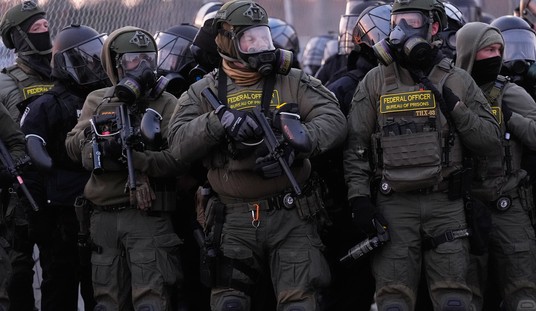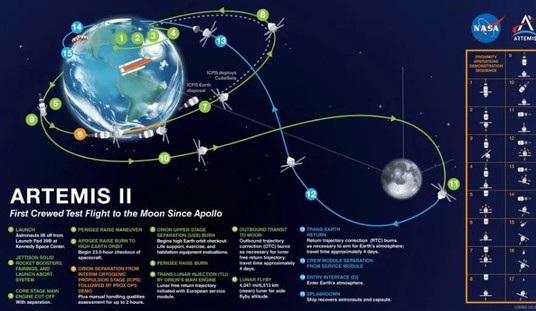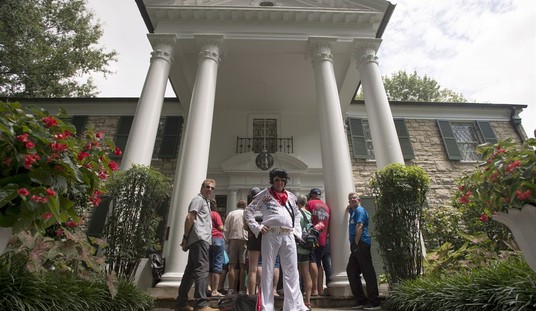Update, 12/18/2018 6:36 pm: According to CNN, the target is a “foreign company”:
4 days after attorneys secretly argued over a grand jury subpoena suspected to be related to Mueller's probe into Russian influence in the 2016 election, a federal appeals court is forcing an unnamed company to comply with the subpoena, @ShimonPro reports. https://t.co/BJ40MUuxud pic.twitter.com/9YTlcIt7xt
— The Situation Room (@CNNSitRoom) December 18, 2018
The secrecy and the security arrangements seem pretty strange under those circumstances. But hey, it’s a strange case, too.
Original post follows …
=======
The saga of Robert Mueller’s mystery subpoena continued yesterday, but only a select few even got to see the players. The DC Circuit Court of Appeals went into a sealed session so secret that the attorneys arguing the case went in undercover, CNN reported. What could possibly be so secret in Mueller’s probe that requires this level of security?
Wanna take a guess who’s name is on the mystery invitation?
But this Friday, court officials went to extreme measures to ensure it was as difficult as possible to figure out what Mueller’s team was doing as the US Court of Appeals for the District of Columbia Circuit held a secret and mysterious argument about a grand jury subpoena challenge.
An entire floor of the courthouse was closed to the public and press for more than an hour. During that time, attorneys secretly entered the courthouse to argue before three federal appellate judges over a grand jury subpoena.
Who went into the courtroom? The press staked out the joint, but saw no one coming or going onto the floor, or even the entire building:
No sign that it was Mueller’s office. No sign of defense counsel. The courthouse security had ushered the lawyers into and out of the building for their secret hearing completely under cover. The sealed hearing stayed confidential.
And then, about 10 minutes after the court activity appeared to wrap for the day, a black Justice Department car rolled into Mueller’s office building, bringing attorneys including Dreeben and Zainab Ahmad back to their home base.
Whatever this case is, it started in mid-August when Judge Beryl Howell’s court received a sealed grand jury subpoena. Former federal prosecutor Nelson Cunningham tried connecting the dots two month later in an analysis for Politico, arguing that the circumstances only fit an attempt to subpoena a high-profile officeholder. The high security around this case doesn’t fit for Roger Stone or Jerome Corsi, or any of the other special-counsel probe figures still left to depose:
Thanks to Politico’s Josh Gerstein and Darren Samuelsohn, we know that on August 16th (the day after Giuliani said he was almost finished with his memorandum, remember), a sealed grand jury case was initiated in the D.C. federal district court before Chief Judge Beryl A. Howell. We know that on September 19, Chief Judge Howell issued a ruling and 5 days later one of the parties appealed to the D.C. Circuit. And thanks to Politico’s reporting, we know that the special counsel’s office is involved (because the reporter overheard a conversation in the clerk’s office). We can further deduce that the special counsel prevailed in the district court below, and that the presumptive grand jury witness has frantically appealed that order and sought special treatment from the judges of the D.C. Circuit – often referred to as the “second-most important court in the land.” …
Back before the D.C. Circuit, this case’s very special handling continued. On October 10, the day the case returned to the court, the parties filed a motion for expedited handling, and within two days, the judges had granted their motion and set an accelerated briefing schedule. The witness was given just 11 days to file briefs; the special counsel (presumably) just two weeks to respond; and reply papers one week later, on November 14 (for those paying attention, that’s 8 days after the midterm elections). Oral arguments are set for December 14.
That brings us to yesterday’s lockdown at the appellate court building, and the odd desire to keep the identities of the litigators from getting into the news. That’s curious enough, but add that to Cunningham’s earlier argument that the fast-tracking of this case indicated that the conflict over the subpoena created a high priority for the court. What subpoena target in a Mueller investigation would warrant this level of secrecy and such an expedited timeline? Why would it be so important to hide the identities of the attorneys?
Perhaps this CNN story from last night gives us the answer:
Robert "Mueller's interest in talking with the President continues," reports Pamela Brown, adding "it includes an interest in asking questions about the President's state of mind in regards to actions under scrutiny in the obstruction probe."https://t.co/JMrUrtTJHz pic.twitter.com/8zjL55a4pl
— Anderson Cooper 360° (@AC360) December 15, 2018
Special counsel Robert Mueller’s team continues to be interested in interviewing the President Donald Trump, two sources familiar with the matter tell CNN.
Mueller’s stance on interviewing the President has been constant for a year and a half, one of the sources said. “Nothing has changed in that sense from the first day,” the source said.
Trump and his lawyers are still opposed to any interview.
Pamela Brown says that there is “no indication that Mueller is moving to subpoena the president.” Let’s posit a theory based on Cunningham’s expert analysis and the bizarre security precautions at the appellate court yesterday for the hearing of oral arguments on this mystery subpoena. Here it is: Mueller and his team file a grand jury subpoena for Trump under seal in August, which Trump’s legal team immediately challenges. It goes up and down between the district and appellate courts for some technical issues at an unheard-of speed (as Cunningham originally notes) and eventually lands at the DC circuit for resolution.
What happens during this period? After months of refusals, we find out a month before yesterday’s hearings that Trump and his attorneys have agreed to answer written questions from the special counsel’s investigators. I asked at the time what had changed their minds, and linked back to Cunningham’s theory that Trump had been subpoenaed. It might have been an attempt to get the subpoena withdrawn before it could either get enforced or go public. There seems to have been little other reason for Trump to answer a questionnaire, especially since the midterms were already over and it was well before the 2020 election cycle. Trump could have just waited out Mueller … unless a grand jury subpoena has been issued and might be enforced.
If that’s what the hearing is about, then why did this story about Mueller being unsatisfied with Trump’s responses leak after yesterday’s hearing? It probably didn’t leak from Mueller’s office, which has been pretty disciplined on information security. It might be Trump’s team getting ready for a bad outcome from the DC Circuit decision on the subpoena case, and prepping the political battlefield for a continued standoff with Mueller. The juxtaposition to the secret hearing seems very curious, although perhaps entirely coincidental … if one is inclined to believe in such coincidences.
If the speed on the DC Circuit decision matches that of the rest of this case so far, we might expect a decision within the next couple of weeks — under seal. Reporters might want to keep a close eye on the Supreme Court docket over the Christmas holidays. And the Supreme Court’s office too, for that matter … to see who’s dropping off paperwork.
Update: One more dot-connection occurs to me, too. Cunningham notes that the subpoenaed witness had to respond to the court by October 21, special counsel had to respond to that filing by November 4th, and then the witness had to respond to the special counsel’s reply by November 14th. That’s the same day that we found out that Trump had been working on Mueller’s written questionnaire, and that he’d been working on it for a week … three days after the subpoena recipient and his attorneys saw the special counsel’s response to the court. That may not be direct evidence that Trump is the subpoena recipient, but it’s mighty coincidental if he’s not.







Join the conversation as a VIP Member